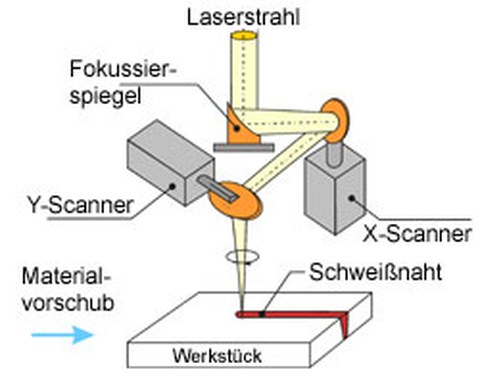Laserstrahlschweißen mit oszillierendem Strahl
Nahezu simultan zur Einführung der Laserstrahltechnologie in die schweißtechnische Praxis wurde eine Erweiterung des Anwendungsspektrums das Laserstrahlschweißens durch zusätzliche prozesstechnische Maßnahmen angestrebt. Beispiele hierfür sind der Einsatz gepulster Lasersysteme, die Mehrstrahltechnik und die zahlreichen Varianten des Laser-Hybridschweißens.
In Ergänzung zu diesen bewährten
Verfahren sind aktuelle Untersuchungen auch auf eine
Prozessmanipulation unter Verwendung optischer Scannersysteme
ausgerichtet. Charakteristisches Merkmal dieser Technologie ist
eine periodische Auslenkung des Strahls über bewegliche
Spiegel, die in den Strahlengang zwischen Laser und Werkstück
integriert sind (Abb. 1, links). Damit lassen sich verschiedene
Oszillationsformen generieren (Abb. 1, rechts), die wiederum
eine gezielte Einflussnahme auf die Energiedeposition
ermöglichen.
Abbildung 1: Verfahrensprinzip zur Realisierung der Strahloszillation (links) sowie Beispiele möglicher Strahloszillationen (rechts).
Aufgrund der Überlagerung von Vorschub- und
Oszillationsbewegung resultieren komplexe Bedingungen für die
Energiedeposition, wobei die resultierenden Zusammenhänge
zwischen den relevanten Einflussgrößen a priori oder mittels
experimenteller Untersuchungen nicht unmittelbar überschaubar
sind. Daher konzentrieren sich aktuelle Forschungsarbeiten am
LOT auf eine umfassende theoretische Beschreibung dieser
Verfahrensvariante und die Entwicklung entsprechender
Simulationsprogramme [1]. Zusätzlich wird das Potenzial des
Laserstrahlschweißens mit oszillierendem Strahl anhand
praktischer Schweißversuche untersucht und bewertet. Hierbei
stehen insbesondere solche Fügeaufgaben im Vordergrund, deren
Ausführung bei konventioneller Prozessführung problematisch
ist, u.a. das Schweißen verzinkter Bleche im spaltfreien
Überlappstoß, das Hochgeschwindigkeitsschweißen, das Fügen
poren- und rissanfälliger Werkstoffklassen sowie das Schweißen
mit Spalt.
Literatur:
[1] A. Mahrle, E. Beyer (2007), Mathematical
Description of the Transient Energy Deposition in Laser
Materials Processing with Forced Beam Oscillations, 20th
Meeting on Mathematical Modelling of Materials Processing with
Lasers, 17-19/01/2007, Igls/Innsbruck (A).


